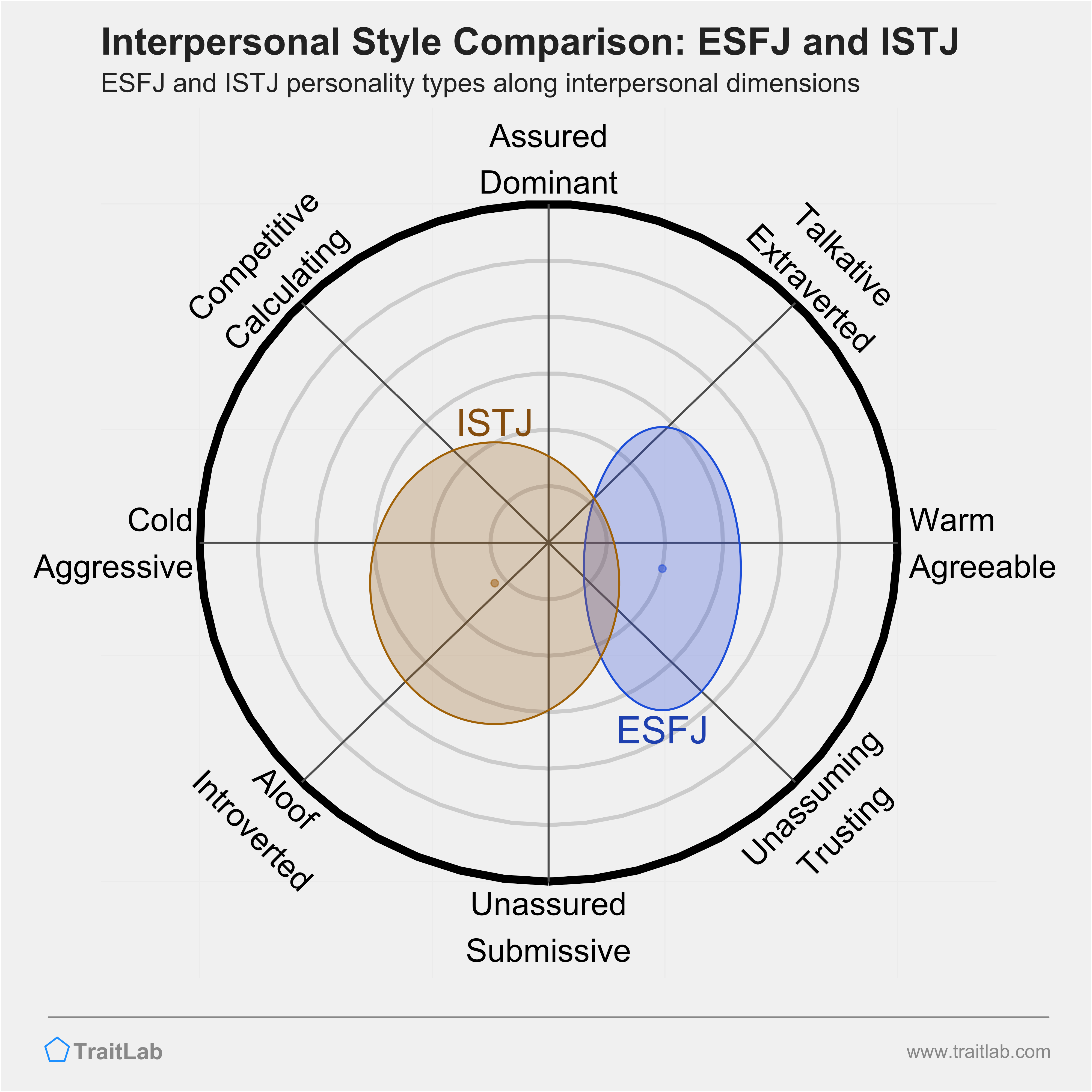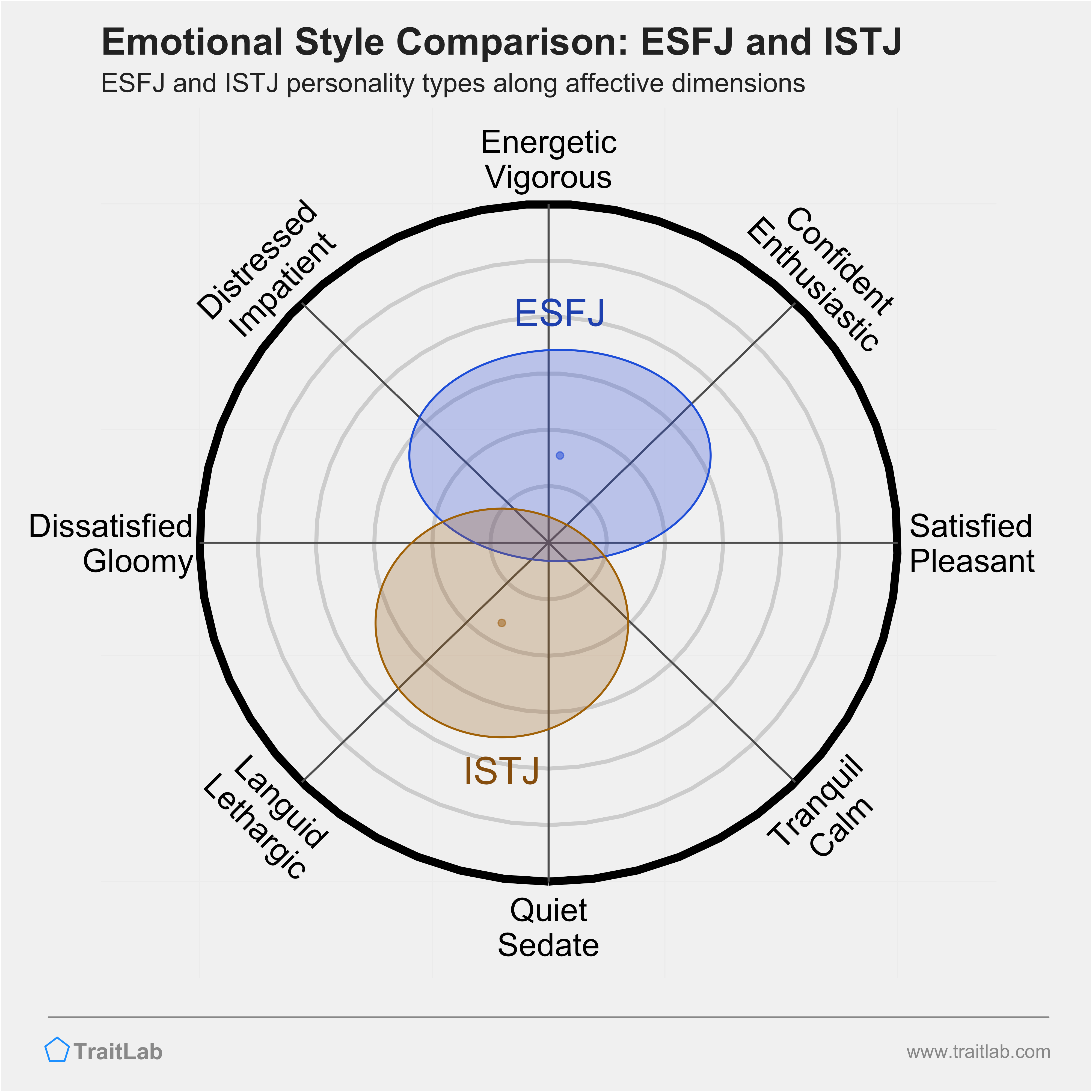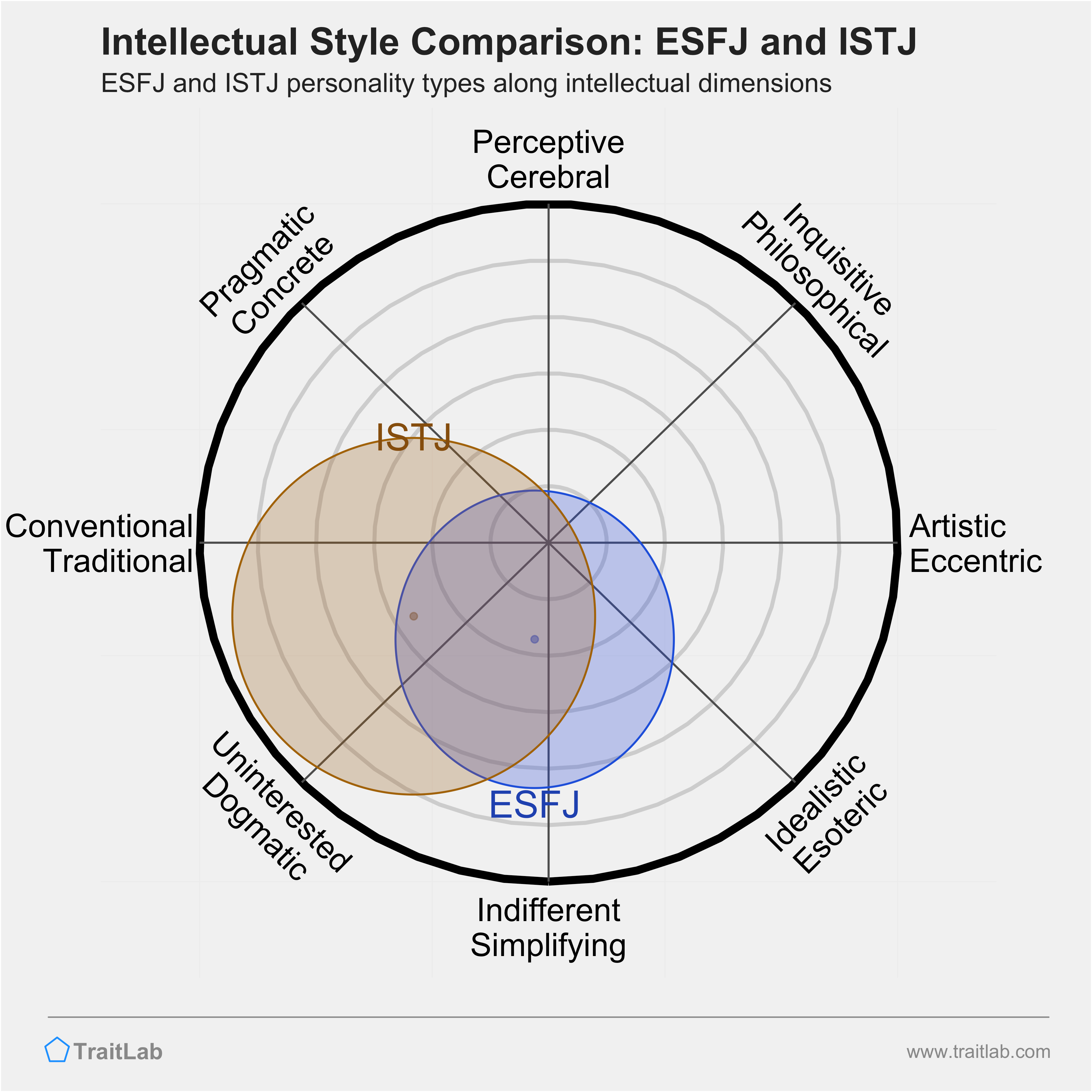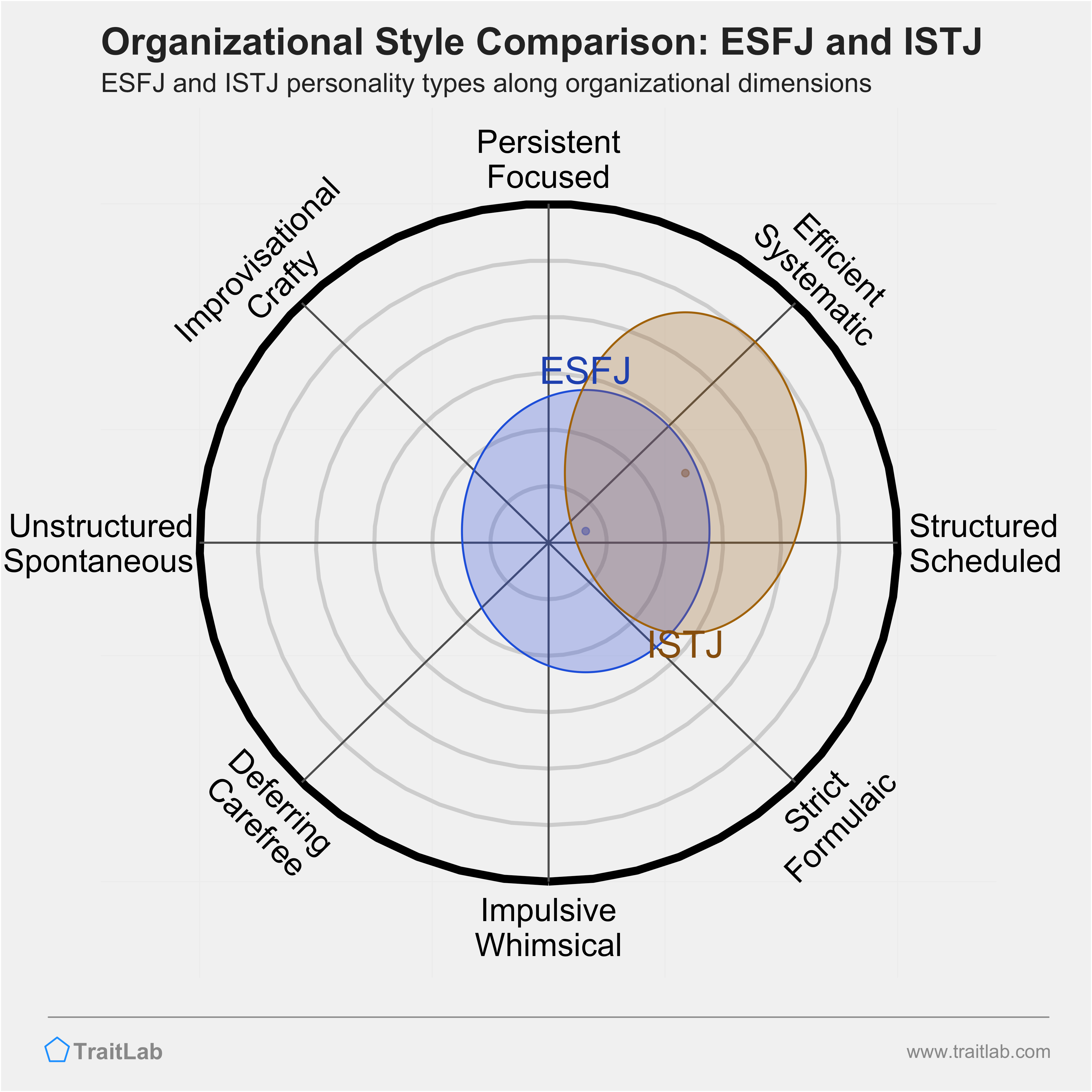How compatible are ESFJ and ISTJ patterns of communicating, thinking, and working?
Reading time: 5 minutes

Gregory Park, Ph.D.
Author
In this article, you’ll find a comparison of ESFJs and ISTJs across five important personality domains: Interpersonal/Communication Style, Emotional Style, Intellectual Style, and Organizational Style.
One important note: the following comparisons cannot be made simply by comparing the cognitive functions (letters) of each personality type.
For this analysis, TraitLab gathered data about personality traits from thousands of participants who identified themselves as a particular type in the 16 Personality or Myers-Briggs framework.
The comparisons here show the average similarities and differences between ESFJs and ISTJs. However, remember that all personality types are oversimplifications. For an assessment of your unique position in these areas, you’ll need a personalized assessment that doesn’t rely on personality types.
Jump to any section with the links below.

Do you know your personality type?
Learn about your type and so much more with TraitLab's comprehensive personality assessment.
Your particular style of communicating and interacting with others can be described fairly well by two dimensions: assertiveness and warmth.
Assertiveness describes your tendency to assert yourself, lead, and influence others in social situations, while warmth describes your tendencies to empathize and put others’ needs ahead of your own.
People with the same personality type often share some similarities in assertiveness and warmth. In the graph below, you can see where most ESFJs and most ISTJs fall along both of these dimensions.
First, take a look at where people in each type, on average, fall in this interpersonal space.

ESFJs often agree, trust, and cooperate with others. At their best, they are friendly, affectionate, and bring out the warmth and sympathy in others. ESFJs may be too agreeable and quick to compromise. At their worst, they may seek approval and agreement too much, and be dependent on the approval of other people.
ISTJs are realists who perceive things and people clearly, without being overly optimistic. At their best, they are practical skeptics who are comfortable holding and sharing unorthodox, unpopular views. ISTJs may be overly skeptical and suspicious, and they may have difficulty trusting others. At their worst, they can struggle to make new friends and socialize, and have a hard time showing affection and admiration for others.
One notable difference between many ESFJs and most ISTJs is in your interpersonal warmth. Like many ESFJs, you are more likely on the warmer, friendlier, more empathetic side of the spectrum. Compared to you and other ESFJs, ISTJs’ interpersonal style can sometimes feel distant, cold, and uninterested in your wants and needs.
However, you and most ISTJs both tend to be on the more reserved and passive side in social situations. On one hand, this is a benefit: both of you tend to be reliable partners, ready and willing to help each other when needed. On the other hand, your mutual passivity can stall decisions and action, especially if both of you are waiting for the other to take the lead.
Another characteristic of your personality is your emotional style — your tendencies towards different kinds of moods. There are two dimensions that influence emotional style: arousal and valence.
Arousal describes your relative energy level across different situations. Those with high baseline levels of arousal tend to be generally more alert, active, and engaged, while those with a lower baseline are more reserved, subdued, and inhibited.
Valence describes whether these moods tend to be positive (pleasant) or negative (unpleasant). People with a more positively valenced style are more likely to experience emotions like joy, enthusiasm, satisfaction, and serenity. People with a more negatively valenced style are more likely to experience sadness, frustration, dissatisfaction, and anxiety.
The graph below shows where each type, on average, usually sits in this emotional space.

ESFJs tend to be energetic and enthusiastic across most situations. They take on new challenges with excitement, confidence, and a sense of adventure. ESFJs are usually more optimistic than most people, and they generally feel like they can handle what life throws at them.
ISTJs have a tendency to be quiet and inhibited. Compared to most people, they can easily drift into gloom and melancholy. They see the glass as half-empty and have a more skeptical outlook and a hesitant approach to life. For better or worse, ISTJs tend to notice the negatives in most situations. In stressful times, they are more likely to withdraw quietly and retreat inward, rather than share their frustration with others.
As with most ESFJs, you tend to have a higher baseline energy level than most ISTJs. Between the two of you, you are more likely to seek out engaging activities — perhaps social events, outdoor adventures, or a new class, depending on your interests. However, you may find that most ISTJs do not share your enthusiasm and excitement. In general, you likely crave stimulation more than your ISTJ counterparts, and balancing your different appetites for excitement can be an ongoing challenge.
Another difference between ESFJs and ISTJ is in their typical emotional valence, which describes tendencies towards positive or negative emotions. You and most ESFJs tend to fall on the more positive side. Compared to most ISTJs, you and most ESFJs experience positive emotions such as joy, satisfaction, and happiness more often than most ISTJs. ISTJs have the opposite pattern, and they tend to gravitate towards more negative emotions.
These subtle emotional differences often surface in your reactions to new information. The same news that sparks enthusiasm in you and most ESFJs can induce worry in ISTJs. Compared to ESFJs, most ISTJs may need additional time and space to recover from stress.
Your intellectual style describes how you receive, process, and pursue different kinds of information. Differences in intellectual style are captured well by two dimensions: ideas and aesthetics.
Ideas describes your appetite for new information and your interest in complex, challenging material. People high on the ideas dimension have an appreciation for complexity and technical details. People lower on ideas are less interested in learning for learning’s sake, and they prefer to simplify complex topics down to the essential details.
Aesthetics captures your relative interest and sensitivity to aesthetic information and its emotional impact. People higher on the aesthetics dimension usually have strong artistic interests and a deep appreciation for beauty in many forms. Those lower on aesthetics tend to value practical application over artistic merit and usually adhere to more conventional standards of beauty.
In the graph below, you’ll see where ESFJs and ISTJs, on average, fall in this intellectual space.

Most ESFJs and ISTJs overlap heavily in their intellectual style.
ESFJs and ISTJs are practical realists. They focus on building practical skills and essential knowledge and are less likely to spend time learning for learning’s sake. In addition, they usually value conventional, tangible accomplishments over artistic expression and rarely feel compelled to develop a creative outlet.
As an ESFJ, you and most ISTJs are down-to-earth, straightforward thinkers. You’d both prefer to stick to the essentials and focus on practical issues, and you try to avoid overcomplicating matters. When you and your ISTJ counterpart are together, your conversations are more likely to revolve around concrete details, facts, and conventional topics rather than theoretical or philosophical ones.
Likewise, ESFJs and ISTJs share an appreciation for practical, tangible accomplishments over artistic expression. ESFJs and ISTJs are both likely to embrace conventional ways of thinking, and both types are more skeptical of eccentric or unusual approaches to solving problems.
Your organizational style describes your habits around organization and planning. Your organizational style influences how you structure your time and physical space. Differences in organizational style fall along two dimensions: industriousness and orderliness.
Industriousness describes your persistence, need for achievement, and intensity of focus. People higher on industriousness usually organize their behavior around a few important long-term goals. People lower on industriousness are usually more focused on the present and will more easily change their focus when new opportunities appear.
Orderliness describes your need for regularity, order, and structure in your environment. People higher on orderliness prefer tidy, organized physical spaces, detailed schedules, and reliable routines. People lower on orderliness can tolerate more disorganization and prefer a more spontaneous, unstructured approach.
The graph below shows the average position of ESFJs and ISTJs along these dimensions of organizational style.

Most ESFJs and ISTJs share a similar organizational style.
ESFJs and ISTJs are usually systematic and highly organized. They like setting big, long-term goals and then creating detailed plans to accomplish them. ESFJs and ISTJs are generally good at ignoring distractions and making steady progress through consistent routines and habits.
As an ESFJ, you and most ISTJs share a natural drive to achieve and perform at a high level. Both of you enjoy setting goals and pushing yourselves to accomplish them, and you likely share an interest in self-improvement and productivity strategies. As a result, you and your ISTJ counterpart can fuel each other’s ambition and keep each other accountable as you work towards your long-term goals. However, between the two of you, nobody usually reminds you to slow down and enjoy the present.
Similarly, ESFJs and ISTJs tend to be neat, tidy, and organized. You both rely on high amounts of structure and routine and compared to most people, you have lower tolerances for messiness and disorder. With a few exceptions, both of you stick closely to most social conventions and feel uncomfortable straying from them.
Most people have complex personalities and don’t fall into a single personality type.
With TraitLab’s comprehensive analyses of your traits, strengths, and interests, you can see how your personality compares to all 16 types. Start building your personality profile by creating a free account today.
For comparisons between ESFJs and other types from the 16 Personality typology, visit any of the type pairings below:
For comparisons between ESFJs and other Enneagram types, visit any of the type pairings below: